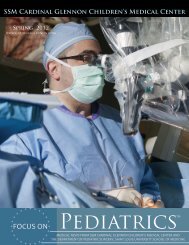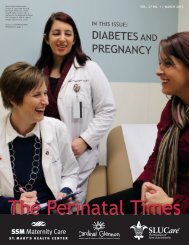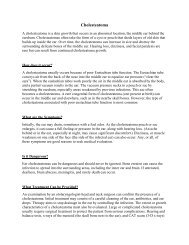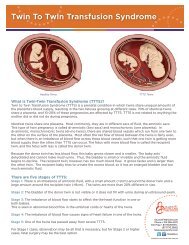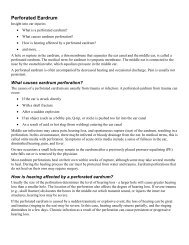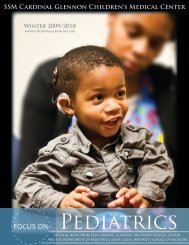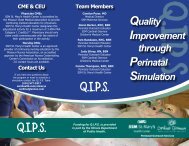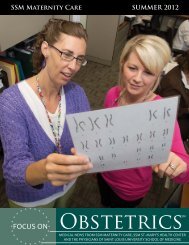pediatric-ALS-AHA-guidelines-circulation_11-2010 - SSM Cardinal ...
pediatric-ALS-AHA-guidelines-circulation_11-2010 - SSM Cardinal ...
pediatric-ALS-AHA-guidelines-circulation_11-2010 - SSM Cardinal ...
You also want an ePaper? Increase the reach of your titles
YUMPU automatically turns print PDFs into web optimized ePapers that Google loves.
Kleinman et al Part 14: Pediatric Advanced Life Support S89993. Mhanna MJ, Zamel YB, Tichy CM, Super DM. The “air leak” testaround the endotracheal tube, as a predictor of postextubation stridor, isage dependent in children. Crit Care Med. 2002;30:2639–2643.94. Browning DH, Graves SA. Incidence of aspiration with endotrachealtubes in children. J Pediatr. 1983;102:582–584.95. Luten RC, Wears RL, Broselow J, Zaritsky A, Barnett TM, Lee T,Bailey A, Vally R, Brown R, Rosenthal B. Length-based endotrachealtube and emergency equipment in <strong>pediatric</strong>s. Ann Emerg Med. 1992;21:900–904.96. Davis D, Barbee L, Ririe D. Pediatric endotracheal tube selection: acomparison of age-based and height-based criteria. AANA J. 1998;66:299–303.97. Daugherty RJ, Nadkarni V, Brenn BR. Endotracheal tube size estimationfor children with pathological short stature. Pediatr Emerg Care. 2006;22:710–717.98. Dullenkopf A, Gerber AC, Weiss M. Fit and seal characteristics of a newpaediatric tracheal tube with high volume-low pressure polyurethanecuff. Acta Anaesthesiol Scand. 2005;49:232–237.99. Dullenkopf A, Kretschmar O, Knirsch W, Tomaske M, Hug M, Stutz K,Berger F, Weiss M. Comparison of tracheal tube cuff diameters withinternal transverse diameters of the trachea in children. Acta AnaesthesiolScand. 2006;50:201–205.100. Salgo B, Schmitz A, Henze G, Stutz K, Dullenkopf A, Neff S, GerberAC, Weiss M. Evaluation of a new recommendation for improvedcuffed tracheal tube size selection in infants and small children. ActaAnaesthesiol Scand. 2006;50:557–561.101. Duracher C, Schmautz E, Martinon C, Faivre J, Carli P, Orliaguet G.Evaluation of cuffed tracheal tube size predicted using the Khineformula in children. Paediatr Anaesth. 2008;18:<strong>11</strong>3–<strong>11</strong>8.102. Katz SH, Falk JL. Misplaced endotracheal tubes by paramedics in anurban emergency medical services system. Ann Emerg Med. 2001;37:32–37.103. Beyer AJd, Land G, Zaritsky A. Nonphysician transport of intubated<strong>pediatric</strong> patients: a system evaluation. Crit Care Med. 1992;20:961–966.104. Andersen KH, Schultz-Lebahn T. Oesophageal intubation can be undetectedby auscultation of the chest. Acta Anaesthesiol Scand. 1994;38:580–582.105. Kelly JJ, Eynon CA, Kaplan JL, de Garavilla L, Dalsey WC. Use of tubecondensation as an indicator of endotracheal tube placement. Ann EmergMed. 1998;31:575–578.106. Poirier MP, Gonzalez Del-Rey JA, McAneney CM, DiGiulio GA.Utility of monitoring capnography, pulse oximetry, and vital signs in thedetection of airway mishaps: a hyperoxemic animal model. Am J EmergMed. 1998;16:350–352.107. Birmingham PK, Cheney FW, Ward RJ. Esophageal intubation: areview of detection techniques. Anesth Analg. 1986;65:886–891.108. Donn SM, Kuhns LR. Mechanism of endotracheal tube movement withchange of head position in the neonate. Pediatr Radiol. 1980;9:37–40.109. Hartrey R, Kestin IG. Movement of oral and nasal tracheal tubes as aresult of changes in head and neck position. Anaesthesia. 1995;50:682–687.<strong>11</strong>0. Bhende MS, Karasic DG, Karasic RB. End-tidal carbon dioxide changesduring cardiopulmonary resuscitation after experimental asphyxialcardiac arrest. Am J Emerg Med. 1996;14:349–350.<strong>11</strong>1. Kelly JS, Wilhoit RD, Brown RE, James R. Efficacy of the FEFcolorimetric end-tidal carbon dioxide detector in children. Anesth Analg.1992;75:45–50.<strong>11</strong>2. Hosono S, Inami I, Fujita H, Minato M, Takahashi S, Mugishima H. Arole of end-tidal CO monitoring for assessment of tracheal intubations invery low birth weight infants during neonatal resuscitation at birth.J Perinat Med. 2009;37:79–84.<strong>11</strong>3. O’Donnell CP, Kamlin CO, Davis PG, Morley CJ. Endotracheal intubationattempts during neonatal resuscitation: success rates, duration,and adverse effects. Pediatrics. 2006;<strong>11</strong>7:e16–21.<strong>11</strong>4. Salthe J, Kristiansen SM, Sollid S, Oglaend B, Soreide E. Capnographyrapidly confirmed correct endotracheal tube placement during resuscitationof extremely low birthweight babies (1000 g). Acta AnaesthesiolScand. 2006;50:1033–1036.<strong>11</strong>5. Campbell RC, Boyd CR, Shields RO, Odom JW, Corse KM. Evaluationof an end-tidal carbon dioxide detector in the aeromedical setting. J AirMed Transp. 1990;9:13–15.<strong>11</strong>6. Bhende MS, Allen WD, Jr. Evaluation of a Capno-Flo resuscitatorduring transport of critically ill children. Pediatr Emerg Care. 2002;18:414–416.<strong>11</strong>7. Bhende MS, Thompson AE, Orr RA. Utility of an end-tidal carbondioxide detector during stabilization and transport of critically illchildren. Pediatrics. 89(pt 1):1042–1044, 1992.<strong>11</strong>8. Bhende MS, Thompson AE. Evaluation of an end-tidal CO2 detectorduring <strong>pediatric</strong> cardiopulmonary resuscitation. Pediatrics. 1995;95:395–399.<strong>11</strong>9. Cardoso MM, Banner MJ, Melker RJ, Bjoraker DG. Portable devicesused to detect endotracheal intubation during emergency situations: areview. Crit Care Med. 1998;26:957–964.120. Ornato JP, Shipley JB, Racht EM, Slovis CM, Wrenn KD, Pepe PE,Almeida SL, Ginger VF, Fotre TV. Multicenter study of a portable,hand-size, colorimetric end-tidal carbon dioxide detection device. AnnEmerg Med. 1992;21:518–523.121. Cantineau JP, Merckx P, Lambert Y, Sorkine M, Bertrand C,Duvaldestin P. Effect of epinephrine on end-tidal carbon dioxidepressure during prehospital cardiopulmonary resuscitation. Am J EmergMed. 1994;12:267–270.122. Ward KR, Yealy DM. End-tidal carbon dioxide monitoring inemergency medicine. Part 2: Clinical applications. Acad Emerg Med.1998;5:637–646.123. Hand IL, Shepard EK, Krauss AN, Auld PA. Discrepancies betweentranscutaneous and end-tidal carbon dioxide monitoring in the criticallyill neonate with respiratory distress syndrome. Crit Care Med. 1989;17:556–559.124. Tobias JD, Meyer DJ. Noninvasive monitoring of carbon dioxide duringrespiratory failure in toddlers and infants: end-tidal versus transcutaneouscarbon dioxide. Anesth Analg. 1997;85:55–58.125. Sharieff GQ, Rodarte A, Wilton N, Bleyle D. The self-inflating bulb asan airway adjunct: is it reliable in children weighing less than 20kilograms? Acad Emerg Med. 2003;10:303–308.126. Sharieff GQ, Rodarte A, Wilton N, Silva PD, Bleyle D. The selfinflatingbulb as an esophageal detector device in children weighingmore than twenty kilograms: A comparison of two techniques. AnnEmerg Med. 2003;41:623–629.127. Klain M, Keszler H, Brader E. High frequency jet ventilation in CPR.Crit Care Med. 1981;9:421–422.128. Morris MC, Wernovsky G, Nadkarni VM. Survival outcomes afterextracorporeal cardiopulmonary resuscitation instituted during activechest compressions following refractory in-hospital <strong>pediatric</strong> cardiacarrest. Pediatr Crit Care Med. 2004;5:440–446.129. Alsoufi B, Al-Radi OO, Nazer RI, Gruenwald C, Foreman C, WilliamsWG, Coles JG, Caldarone CA, Bohn DG, Van Arsdell GS. Survivaloutcomes after rescue extracorporeal cardiopulmonary resuscitation in<strong>pediatric</strong> patients with refractory cardiac arrest. J Thorac CardiovascSurg. 2007;134:952–959 e952.130. Huang SC, Wu ET, Chen YS, Chang CI, Chiu IS, Wang SS, Lin FY, KoWJ. Extracorporeal membrane oxygenation rescue for cardiopulmonaryresuscitation in <strong>pediatric</strong> patients. Crit Care Med. 2008;36:1607–1613.131. Allan CK, Thiagarajan RR, Armsby LR, del Nido PJ, Laussen PC.Emergent use of extracorporeal membrane oxygenation during <strong>pediatric</strong>cardiac catheterization. Pediatr Crit Care Med. 2006;7:212–219.132. Chan T, Thiagarajan RR, Frank D, Bratton SL. Survival after extracorporealcardiopulmonary resuscitation in infants and children with heartdisease. J Thorac Cardiovasc Surg. 2008;136:984–992.133. del Nido PJ, Dalton HJ, Thompson AE, Siewers RD. Extracorporealmembrane oxygenator rescue in children during cardiac arrest aftercardiac surgery. Circulation. 1992;86(5 Suppl):II300–304.134. Duncan BW, Ibrahim AE, Hraska V, del Nido PJ, Laussen PC, WesselDL, Mayer JE, Jr., Bower LK, Jonas RA. Use of rapid-deploymentextracorporeal membrane oxygenation for the resuscitation of <strong>pediatric</strong>patients with heart disease after cardiac arrest. J Thorac CardiovascSurg. 1998;<strong>11</strong>6:305–3<strong>11</strong>.135. Hoskote A, Bohn D, Gruenwald C, Edgell D, Cai S, Adatia I, VanArsdell G. Extracorporeal life support after staged palliation of a functionalsingle ventricle: subsequent morbidity and survival. J ThoracCardiovasc Surg. 2006;131:<strong>11</strong>14–<strong>11</strong>21.136. Ibrahim AE, Duncan BW, Blume ED, Jonas RA. Long-term follow-upof <strong>pediatric</strong> cardiac patients requiring mechanical circulatory support.Ann Thorac Surg. 2000;69:186–192.137. Prodhan P, Fiser RT, Dyamenahalli U, Gossett J, Imamura M, JaquissRD, Bhutta AT. Outcomes after extracorporeal cardiopulmonary resuscitation(ECPR) following refractory <strong>pediatric</strong> cardiac arrest in theintensive care unit. Resuscitation. 2009;80:<strong>11</strong>24–<strong>11</strong>29.Downloaded from circ.ahajournals.org by on October 20, <strong>2010</strong>




